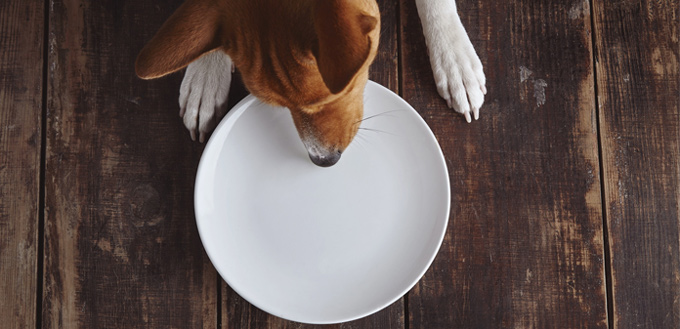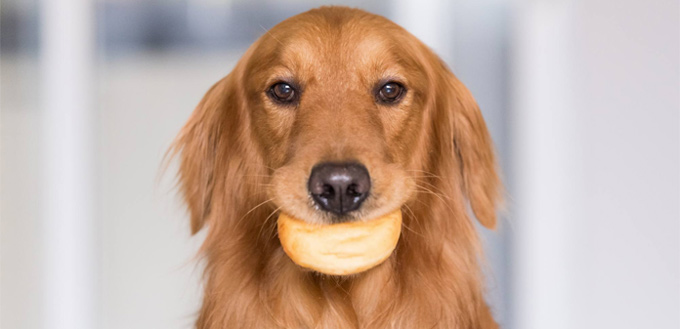Bread forms an integral part of the human diet. Over the years it has become a popular food item that can be eaten at any time of the day in various forms. Owing to its easy availability, bread is something that even pets are familiar with and like to dig into every once in a while. However, like many other food types that are good for humans but may not be good for pets, bread is something that your canine can do without.
Pets tend to yearn for human foods, although these need not be included in their daily diet. So do not be surprised when you catch your pooch munching leftover slices of bread. What is important at this point is to find out if it is safe for your dog to have bread and if it truly benefits its health in any way.

Can Dogs Eat Bread?
Yes, dogs can eat bread but it should be served in moderation. Bread is not toxic for your dog – however, you need to be careful regarding the choice of bread before feeding it to your dog. Moderation is the key that you need to bear in mind while sharing a bite of your favorite sandwich with your pooch. If your dog is not allergic to any of the ingredients used in the bread, then by all means you can go ahead and include it in one of the meals.
If your dog is on a proper and balanced diet and exercises regularly, feeding bread is considered safe. That being said, bread does not have any nutritional value and hence will not fortify your pet’s health. Being carnivorous by nature, dogs can do without human foods like bread. The only purpose that bread serves is to add glamor and a sense of sharing when it is included with good quality dog food.
Is It Safe For Your Dog To Eat Bread?
You need to bear in mind certain aspects before feeding bread to your pooch. Wheat is the main ingredient in most forms of bread, unless mentioned otherwise. If your dog is allergic to wheat, bread is definitely not a good option.
No matter which type of bread you might feed to your dog, the quantity should not exceed 5% of your dog’s regular meal. Always remember to choose bread that has low sugar content. You should also be aware that because bread is full of carbs, including it in the diet will cause weight gain sooner than you realize.
Bread may not be toxic but there are times wherein you need to be careful while feeding it to your dog.
Risks of Feeding Bread to Your Dog
Bread dough has been marked as one of the food hazards for dogs, and it is not due to the flour and water but because of yeast, which is an important ingredient in the preparation of bread. If the dog eats bread dough, the yeast in the dough that makes it rise could cause the stomach of the dog to distend. As a result of the reaction, the toxic levels of ethanol are also released into the dog’s bloodstream.
The pressure that the rising dough creates within the stomach of your pooch causes bloating. However, the maximum danger is from the alcohol toxicosis which could results in depressed central nervous system, weakness, seizures, and an unsteady and drunken gait. Eventually, your canine friend would slip into comatose state.
Some types of bread also contain toxic ingredients that should never be fed to dogs, like fruits, nuts, and raisins. Usually, commercial varieties include additives to enhance the texture, flavor, nutrition, color and shelf life. Xylitol is another ingredient that you must be careful about. If it is present in the bread that you have chosen for your dog, be prepared that it might cause severe health problems.
Raisins are dangerous for your dog because they are highly toxic, affect kidneys, and could be fatal. So raisin bread is strictly prohibited for your pooch since even the part that does not contain raisin might prove harmful.
Bread types that contain nuts and seeds are quite tempting to humans owing to their health benefits and flavor. But do not try feeding such flavored bread to your dog. Nuts in general are not a healthy option for your pooch as they could cause stomach irritation and pancreatitis. In the nut family, Macadamia nuts hold the record for causing maximum problems to a dog.
Artificial sweeteners and additives are to be avoided strictly. To this effect, banana bread and onion and garlic bread are some types that are a complete no-no. For instance, onion and garlic bread could damage the red blood cells of your dog. In banana bread you often find chocolate chips that are toxic for your dog. Therefore, such kinds of bread are to be steered clear of.
Bread that has mold or is stale should be strictly avoided. Like humans, dogs too can suffer from the toxic effects of mold and it is for this reason that dogs should not have bread crust either.
Which Bread Should You Feed To Your Dog?
Whole grain bread is always the best choice for your dog. This type contains no such ingredient that might harm your pet. Besides being safe, whole grain bread contains dietary fiber that enhances the bowel movement of your dog. Some dogs are gluten intolerant, and for them opt for bread that is gluten free.
You May Also Like: Grain Free Dog Food
How Much Bread Should You Serve Your Dog?
Pet owners who want to stay safe can give pieces of brown bread to their dogs occasionally. Never give a whole loaf of bread as it could lead to intense stomach ache and bloating.

Final Word
Bread as an occasional treat for your dog is safe. Uncooked bread is not recommended. Ingredients that various flavored varieties of bread contain might prove toxic for your pooch. So you have to be careful before choosing bread for your dog.
Remember bread is not a part of your dog’s diet and does no good to your pooch. Occasionally you might share a bite of your sandwich but always try and opt for healthier treats for your dog.
Sources:
- Anna Burke, Can Dogs Eat Bread?, The American Kennel Club
- People Foods to Avoid Feeding Your Pets, American Society for the Prevention of Cruelty to Animals






